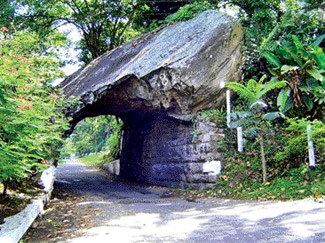Colombo-Kandy road and the Dawson Tower
*******
Many of you who travel on the
Colombo-Kandy road may not give much thought as to why this road was
initially built and who is responsible for its existence. Come journey
on this road with me and you will learn about it and also why the column
erected on a cliff above the Kadugannawa Pass is so significant.
********
Before the Colombo-Kandy road (A1) was built, the route to Kandy from
Colombo was along the Kelani Valley to Ruwanwella. From Ruwanwella a
road led to the Ma Oya valley; then along the Ma Oya valley to Gampola.
From Gampola there was a good road to Kandy. This route was long,
tiring and time consuming (taking up much time).
Although the British annexed the Kandyan kingdom in March 1815, they
could not take full control. The chiefs of the old kingdom were still
powerful and they would not take orders from the new white rulers. There
was a rebellion in 1818.
The British put down the rebellion killing many of the chiefs, among
them Keppetipola Maha Disawa.
After this rebellion, the Governor realised that to take full control
of the hill country, there should be a quick and shorter route to Kandy.
So, Governor Edward Barnes decided to build a new road, a quick and
shorter one from Colombo to Kandy and appointed Captain William Francis
Dawson of the Royal Commanding Engineers to plan and construct this
road.
We who travel up and down the Kandy road today, cannot imagine the
difficulties Captain Dawson surmounted (got over) and the dangers he
faced to build this road. Over 190 years ago when Captain Dawson took up
this work, the whole land from the summit of the central hills to the
sea coast was one huge forest with villages scattered here and there
like islands in this sea of trees.
This short account left by a sportsman (one who shoots animals for
pleasure), gives an idea of the arduous and dangerous task Captain
Dawson undertook.
“In this great and unbroken forest, elephants roamed in broad
daylight, wild pigs roamed about in countless numbers, spotted deer
grazed in the glades, leopards waited to prey upon them and buffaloes
charged an enemy in a body.
The rivers were teeming with crocodiles assimilating (taking on) the
colour of the mud in which they lay during the day.” Apart from these,
there were numerous reptiles, porcupines, jungle rats and monkeys.
To mark the route the Captain had to cross rivers which were torrents
during rains, plod through swamps, cross rocky ground and ravines, and
climb hill after hill. The bends that begin a few kilometres before
Ambanpitiya continue upto the Kadugannawa Pass.
Work on the construction of the road began in 1820. Captain Dawson
was on the site directing and supervising the work done by locals, then
called ‘natives’.
This was the first road built by the British. Except for the stretch
of road from Warakapola to Ambanpitiya - a distance of 11 miles -
constructed under the supervision of Major Thomas Skinner, the rest of
the work was directed and supervised by Captain Dawson.
To have built a road this long without the implements and technical
know-how we have today, to have blasted a rock to make a tunnel for
vehicles to pass through, is testimony to Captain Dawson’s skill and
technical knowledge.
Unfortunately, Captain Dawson couldn’t live to see his work
completed. He was taken ill suddenly and brought to Colombo. It was said
that he had been bitten by a venomous snake He died on March 28, 1829.

Major Skinner who worked closely with Captain Dawson, wrote in his
diary. “I have lost a dear friend and a great officer.
He died in my arms. The news of his death was received with great
sorrow. He was liked by all”.
It look nearly another two years to complete the road. In 1831 the
first mail coach left Colombo and went along the new road to Kandy. It
was a great triumph but a triumph clouded with sadness, for Captain
Dawson was not there to witness this historic journey.
Captain Dawson’s friends and colleagues felt that there should be an
appropriate memorial to him, and they conveyed their proposal to the
Governor.
By then, Governor Barnes had left and Sir Robert Horton was Governor.
He had himself seen the work done by Captain Dawson and he readily gave
his assent to the proposal. The site chosen for the memorial was the
cliff above the Kadugannawa Pass - the rock which was blasted to form
the tunnel.The foundation stone for this memorial - a white column was
laid on the same day that the foundation for the memorial to the Duke of
Wellington was laid in Hyde Park, London.
The Dawson Tower was built to the same height as Wellington’s Tower -
200 feet. In 1815 Napolean was defeated in the Battle of Waterloo which
was a turning point in European history and it was the Duke of
Wellington who led that battle. It was a special tribute to Captain
Dawson that his memorial should be of the same height as the memorial to
the Duke of Wellington. You can’t miss this column as you climb up to
the Kadugannawa Pass or come down from Kandy.
When you next go that way, tell your parents to take the first turn
to the right after the pass (the Gampola road) and after a few yards
turn right again into the path that leads to Dawson’s Tower.
- Sumana Saparamadu |

